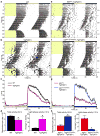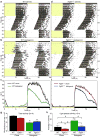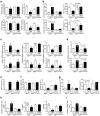FGF21 regulates metabolism and circadian behavior by acting on the nervous system
- PMID: 23933984
- PMCID: PMC3769420
- DOI: 10.1038/nm.3249
FGF21 regulates metabolism and circadian behavior by acting on the nervous system
Abstract
Fibroblast growth factor 21 (FGF21) is a hepatokine that acts as a global starvation signal to modulate fuel partitioning and metabolism and repress growth; however, the site of action of these diverse effects remains unclear. FGF21 signals through a heteromeric cell-surface receptor composed of one of three FGF receptors (FGFR1c, FGFR2c or FGFR3c) in complex with β-Klotho, a single-pass transmembrane protein that is enriched in metabolic tissues. Here we show that in addition to its known effects on peripheral metabolism, FGF21 increases systemic glucocorticoid levels, suppresses physical activity and alters circadian behavior, which are all features of the adaptive starvation response. These effects are mediated through β-Klotho expression in the suprachiasmatic nucleus of the hypothalamus and the dorsal vagal complex of the hindbrain. Mice lacking the gene encoding β-Klotho (Klb) in these regions are refractory to these effects, as well as those on metabolism, insulin and growth. These findings demonstrate a crucial role for the nervous system in mediating the diverse physiologic and pharmacologic actions of FGF21.
Conflict of interest statement
The authors declare no competing financial interests.
Figures




Comment in
-
Neuroendocrinology: FGF21-central pathways of action unravelled.Nat Rev Endocrinol. 2013 Oct;9(10):563. doi: 10.1038/nrendo.2013.168. Epub 2013 Aug 27. Nat Rev Endocrinol. 2013. PMID: 23979317 No abstract available.
-
Neuroendocrinology: Signalling starvation.Nat Rev Neurosci. 2013 Oct;14(10):670-1. doi: 10.1038/nrn3592. Epub 2013 Aug 29. Nat Rev Neurosci. 2013. PMID: 23985832 No abstract available.
-
Forever (FGF) 21.Nat Med. 2013 Sep;19(9):1090-2. doi: 10.1038/nm.3334. Nat Med. 2013. PMID: 24013744
Similar articles
-
FGF21 contributes to neuroendocrine control of female reproduction.Nat Med. 2013 Sep;19(9):1153-6. doi: 10.1038/nm.3250. Epub 2013 Aug 11. Nat Med. 2013. PMID: 23933983 Free PMC article.
-
Forever (FGF) 21.Nat Med. 2013 Sep;19(9):1090-2. doi: 10.1038/nm.3334. Nat Med. 2013. PMID: 24013744
-
betaKlotho is required for fibroblast growth factor (FGF) 21 signaling through FGF receptor (FGFR) 1c and FGFR3c.Mol Endocrinol. 2008 Apr;22(4):1006-14. doi: 10.1210/me.2007-0313. Epub 2008 Jan 10. Mol Endocrinol. 2008. PMID: 18187602 Free PMC article.
-
FGF21 in obesity and cancer: New insights.Cancer Lett. 2021 Feb 28;499:5-13. doi: 10.1016/j.canlet.2020.11.026. Epub 2020 Nov 29. Cancer Lett. 2021. PMID: 33264641 Free PMC article. Review.
-
The FGF21 Receptor Signaling Complex: Klothoβ, FGFR1c, and Other Regulatory Interactions.Vitam Horm. 2016;101:17-58. doi: 10.1016/bs.vh.2016.02.008. Epub 2016 Mar 24. Vitam Horm. 2016. PMID: 27125737 Review.
Cited by
-
Central Fibroblast Growth Factor 21 Browns White Fat via Sympathetic Action in Male Mice.Endocrinology. 2015 Jul;156(7):2470-81. doi: 10.1210/en.2014-2001. Epub 2015 Apr 29. Endocrinology. 2015. PMID: 25924103 Free PMC article.
-
Exploring endocrine FGFs - structures, functions and biomedical applications.Int J Biochem Mol Biol. 2024 Aug 25;15(4):68-99. doi: 10.62347/PALK2137. eCollection 2024. Int J Biochem Mol Biol. 2024. PMID: 39309613 Free PMC article. Review.
-
Impaired Mitochondrial Fat Oxidation Induces FGF21 in Muscle.Cell Rep. 2016 May 24;15(8):1686-99. doi: 10.1016/j.celrep.2016.04.057. Epub 2016 May 12. Cell Rep. 2016. PMID: 27184848 Free PMC article.
-
Linking Nonalcoholic Fatty Liver Disease and Brain Disease: Focusing on Bile Acid Signaling.Int J Mol Sci. 2022 Oct 27;23(21):13045. doi: 10.3390/ijms232113045. Int J Mol Sci. 2022. PMID: 36361829 Free PMC article. Review.
-
Neural control of energy balance: translating circuits to therapies.Cell. 2015 Mar 26;161(1):133-145. doi: 10.1016/j.cell.2015.02.023. Cell. 2015. PMID: 25815991 Free PMC article. Review.
References
-
- Kharitonenkov A, et al. FGF-21/FGF-21 receptor interaction and activation is determined by betaKlotho. Journal of cellular physiology. 2008;215:1–7. - PubMed
Publication types
MeSH terms
Substances
Grants and funding
- P01 DK088761/DK/NIDDK NIH HHS/United States
- U19 DK062434/DK/NIDDK NIH HHS/United States
- T32 GM007062/GM/NIGMS NIH HHS/United States
- 1RL1GM084436-01/GM/NIGMS NIH HHS/United States
- RL1 GM084436/GM/NIGMS NIH HHS/United States
- P20 RR020691/RR/NCRR NIH HHS/United States
- HHMI_/Howard Hughes Medical Institute/United States
- RL1 DK081185/DK/NIDDK NIH HHS/United States
- P01DK088761/DK/NIDDK NIH HHS/United States
- U19DK62434/DK/NIDDK NIH HHS/United States
- R01 DK067158/DK/NIDDK NIH HHS/United States
- P20RR20691/RR/NCRR NIH HHS/United States
- RL1DK081185/DK/NIDDK NIH HHS/United States
- GM007062/GM/NIGMS NIH HHS/United States
- R01DK067158/DK/NIDDK NIH HHS/United States
LinkOut - more resources
Full Text Sources
Other Literature Sources
Molecular Biology Databases

